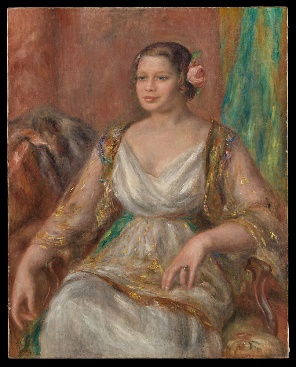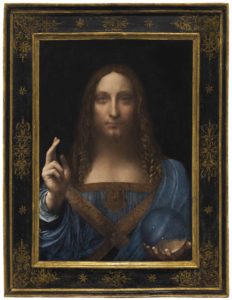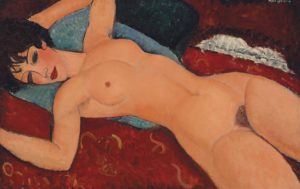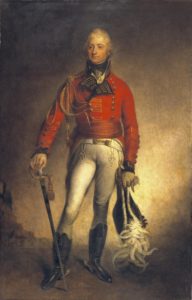COMMENTS ON THE ART MARKET
Gallery News
Transition Phase
The New View – At Least For Now

The end of August has arrived, and with that, the end of our lease on 57th Street. In the late 1970s, the gallery moved from a space on Park Avenue South to one on East 63rd Street. We enjoyed our time there, but the building was sold, went residential, and we were forced out after about 20 years. Some 26 years ago we moved to East 57th Street and worked on building both the historical and contemporary side of our gallery.

Over the years, the 57th Street space got smaller and smaller, or should I say with the growth of our contemporary gallery, there just wasn’t enough room. You know, artists keep painting and painting! Not to mention the additional staff (gotta love Travis and Ollie, who were not happy to leave). We are not complaining, we just needed more room. Since we were unable to secure a new lease early on, we were forced to rent a storage space at Uovo (a really nice art storage facility in Long Island City). It now appears that our new gallery space at 20 West 55th Street (5th Floor) will not be ready until early 2023. As such, we are all working remotely (something many of us have gotten used to over the past 2 years). The view from my outdoor office space is very nice — at least while the weather is being cooperative. Not sure I will feel the same way in the middle of December.
We will continue to update everyone on the progress of the buildout at our new location. As I have mentioned before, we are always available by phone (212) 355-5710, email, and at several upcoming shows — the first of which are in Baltimore, Boston, and Winnetka.
The Process Has Begun: Demolition
 I am pleased to report that the initial phase of our new space at 20 West 55th Street has begun … demolition! Alyssa and I went to the space the other day for a meeting with the building’s architect to discuss a few small issues that arose after the demolition. Nothing real serious, but a column emerged in the exact location of an office door. It turned out to be an easy fix.
I am pleased to report that the initial phase of our new space at 20 West 55th Street has begun … demolition! Alyssa and I went to the space the other day for a meeting with the building’s architect to discuss a few small issues that arose after the demolition. Nothing real serious, but a column emerged in the exact location of an office door. It turned out to be an easy fix.
Our recent visit was the first time we saw the space without the previous tenant’s buildout. They were some sort of financial company, so there were many smaller offices and an area in the back where people sat at long desks with computer screens — it looked like one of those scenes from a movie. You know, dozens of people with computer screens and telephones, buying and selling stocks, etc.
It will be a couple of weeks before the architect has formal plans for us to review. We will keep you posted on the progress.
We Are Now Closed … But Only For A Few Months

I am pleased to report that our transition to the storage facility in Long Island City is moving along quickly. Over the past few weeks, our fine art movers have made four trips to UOVO with most of our artwork, library, and files. This week, while Amy and I are on the road, Lance and Alyssa worked hard packing up the remaining artwork, books, and ‘stuff’ — they even finished boxing up most of my office (I cannot wait to get back to see what is left). At this point, our gallery is almost empty.
We learned this week that the building we are moving into has started demoing the existing space, and as soon as they are completed, we will tour the space with the architect so they can finish the drawings. This is going to be an exciting time for us.
Please remember that the gallery will still be buying and selling works during this transition phase and participating in several shows and fairs over the next few months. Our weekly updates and monthly newsletter will continue as well.
We will continue to update you on the progress of our new space and look forward to welcoming you in 2023!
Upcoming Shows
Boston
We are pleased to announce that we received our complimentary ticket for the Boston International Fine Art Show. These tickets are in the form of a PDF, so if you would like to attend just email us and we will send them to you. Please note that each ticket is good for 2 people.
Please send tickets for the Boston Show
The Cyclorama
Boston Center For The Arts
539 Tremont St
Boston, MA 02116
October 21: 1pm - 8pm
October 22: 11am - 8pm
October 23: 11am - 5pm
Baltimore
We still have a handful of complimentary tickets left. Please send us an email if you would like to attend. Show details are as follows:
Please send tickets for the Baltimore Show
Baltimore Convention Center
One West Pratt Street
Baltimore, MD 21201
October 20: 11am – 6pm
October 21: 11am – 6pm
October 22: 11am – 6pm
October 23: 11am – 6pm
______________________
In The News
Another Unknown Daniel Ridgway Knight Surfaces

Rehs Galleries Inc., the New York gallery specializing in 19th and 20th-century works of art, recently discovered Coming Through the Rye, a previously unknown painting by the American Ex-patriate artist Daniel Ridgway Knight (1839-1924).
Born in Chambersburg, PA, Ridgway Knight received his formal training at the Pennsylvania Academy of Fine Arts, where he was a classmate of Thomas Eakins and Mary Cassatt. In the early 1860s, he traveled to Paris and studied with Alexandre Cabanel and Charles Gabriel Gleyre. In 1863, he returned to the United States to serve in the Civil War; during this time, he met Rebecca Morris Webster. The two were married in 1871, and the following year the couple traveled back to France, where they would remain for the rest of their lives.
Once settled in France, they became friendly several artists including Renoir, Sisley, and Meissonier (the latter of which he developed a close relationship). Ridgway Knight's 1875 Paris Salon painting Les laveuses (Wash Day) received critical acclaim and was inspired by a Meissonier sketch.
Coming Through the Rye (circa 1899) is a unique image, capturing one of his favorite models, Madeleine, walking down a path in the town of Rolleboise (about 40 miles west of Paris). Little is known about its very early history, but it ended up in the collection of Patrick Cudahy (1849-1919). Cudahy was born in Ireland and emigrated to the US with his family when he was a baby. Later, he worked at the Plankinton and Armour meat packing plant and became the superintendent in 1874, taking over the company with his brother John in 1888 and changing its name to Cudahy Brothers.
In 2022, the current owners, descendants of Patrick Cudahy, decided to sell the painting, and their representative contacted Rehs Galleries (the gallery, along with Professor Janet Whitmore, are currently researching the life of Daniel Ridgway Knight for the forthcoming virtual catalogue raisonné). Howard Rehs, the gallery's owner, stated, "When I received the initial images, I was amazed by the scene. Knight typically captured his models in one of the private gardens of Rolleboise; this one was different. The model (Madeleine) is carrying a pitchfork while walking down a path. In the distance, you can see the roofs of a few homes and a piece of the Seine River; in the upper right is Saint Michel. On top of all that, the painting appeared to be in original condition."
The gallery arranged to have the painting shipped in for their inspection. Upon arrival, they confirmed its authenticity and that it was in outstanding condition. Sadly though, it no longer had its original frame; the work arrived in an insert behind a dirty piece of glass. Thankfully, the gallery had an original Ridgway Knight frame in its storage area, and the painting was a perfect fit.
Coming Through the Rye is currently available on the gallery's website and will be featured in several upcoming fairs.
____________________
Stocks & Crypto
By: Lance
After some nice gains in July, August looked to keep the momentum going. For a couple of weeks it appeared that was going to be the case, but it was too good to be. Wall Street has been able to power through consistent interest rate hikes for months now… but perhaps it is finally catching up, not to mention the Fed has signaled they will continue to aggressively fight inflation with continued increases. No matter the cause, the three major indexes fell sharply to close out the month, resulting in the worst August performance since 2015.
The Dow and S&P both were up about 4% in mid-August, but fell 8% in the final two weeks and closed out down more than 4% for the month. The NASDAQ saw even more turbulence, up nearly 6% and falling more than 10% in the final weeks to finish off down 4.5%. Most indications are that we experienced a bear market rally and things will continue to decline… especially considering September is historically the worst month of the year for stocks – yikes!
When it comes to the Pound and Euro, both saw volatility that landed them in the red for August… the Pound has fallen more than 5% in relation to the US Dollar, while the Euro is down just 1.5%. That said, the Fed hikes seem to have sparked a bit of a recovery for the European currency as it was down more than 2.5% just days ago.
As for commodities… Gold saw some moderate fluctuations, ultimately trending downward along with the markets in the final weeks, down about 2.25% for August. Crude was far more volatile, experiencing weekly gyrations… at one point it was down 12%, and crossed into the $80s for the first time since February – it finished the month down 7%.
As for crypto… I deleted Coinbase off my phone, if that gives you any indication of how things are going. I just don’t have it in me to keep looking at it. I’m just doing it once today for all of you… Bitcoin is back to flirting with $20K, dipping below briefly just a few days ago – it’s slid more than 13% this month. Ethereum was trending to get back above $2K, but reversed course and is now in the $1,500 range. And Litecoin is down nearly 10% for the month at a paltry $54.
I cannot stress this enough… I have no idea what will happen! But all signs are pointing to a continued difficulties for the stock market. If you haven’t yet already, perhaps it is time to adjust your investment strategy, at least in the short term. Keep holding on… the ride isn’t over yet.
____________________
The Dark Side
By: Nathan
Label Your Loot: The New Law For New York Museums
Since the end of the Second World War, cultural institutions worldwide have tried to deal with how to approach art stolen or appropriated by the Nazis. Some museums have been very open about acknowledging the problematic provenance of some of their pieces, returning the works to their original owners when requested. But still, many want to sweep all that under the rug. Sometimes, a museum will deny that paintings in their collections were ever stolen or looted in the first place. Notably, Houston’s Museum of Fine Arts did just that last year. But now, this won’t really be too much of an issue for museums in the state of New York because of a new law signed by Governor Kathy Hochul.
 “An act to amend the education law, in relation to notice of art stolen during the Nazi era in Europe” was introduced in the New York State Senate in January 2021 by state senator Anna Kaplan. It specifies that museums in New York must disclose which works in their collections “changed hands due to theft, seizure, confiscation, forced sale or other involuntary means in Europe during the Nazi era”. This will be done through information cards or placards accompanying the works, and apply to the works in New York that meet the law’s requirements, like Republican Automatons by George Grosz (kept at the Museum of Modern Art), Le Moulin de la Galette by Pablo Picasso (at the Guggenheim), and Portrait of Tilla Durieux by Pierre-Auguste Renoir (at the Metropolitan Museum of Art). According to Senator Kaplan, “With the history of the Holocaust being so important to pass on to the next generation, it’s vital that we be transparent and ensure that anyone viewing artwork stolen by the Nazis understand where it came from and its role in history.” The bill made its way through both houses of the New York State Legislature this year, with Governor Hochul signing it into law at Manhattan’s Museum of Jewish Heritage on August 10th. This is actually one of three new laws signed by the governor on the same day regarding Holocaust education and reparation payments for Holocaust survivors.
“An act to amend the education law, in relation to notice of art stolen during the Nazi era in Europe” was introduced in the New York State Senate in January 2021 by state senator Anna Kaplan. It specifies that museums in New York must disclose which works in their collections “changed hands due to theft, seizure, confiscation, forced sale or other involuntary means in Europe during the Nazi era”. This will be done through information cards or placards accompanying the works, and apply to the works in New York that meet the law’s requirements, like Republican Automatons by George Grosz (kept at the Museum of Modern Art), Le Moulin de la Galette by Pablo Picasso (at the Guggenheim), and Portrait of Tilla Durieux by Pierre-Auguste Renoir (at the Metropolitan Museum of Art). According to Senator Kaplan, “With the history of the Holocaust being so important to pass on to the next generation, it’s vital that we be transparent and ensure that anyone viewing artwork stolen by the Nazis understand where it came from and its role in history.” The bill made its way through both houses of the New York State Legislature this year, with Governor Hochul signing it into law at Manhattan’s Museum of Jewish Heritage on August 10th. This is actually one of three new laws signed by the governor on the same day regarding Holocaust education and reparation payments for Holocaust survivors.
While the new laws certainly will do more good than harm, the language appears exclusive. The New York law will only apply to any of those artworks whose ownership was affected by Nazi action and policy. There are about 600,000 pieces of art that fall under this categorization. But art stolen or appropriated because of armed conflict or instability exists beyond the Holocaust. Furthermore, the law only talks about acknowledgment instead of next steps like restitution. Perhaps the New York law can be a first step or a model for future action regarding stolen or looted art.
Stealing Paintings Using… Psychics?
 I’m incredibly skeptical and often outright dismissive of the paranormal, especially when people use it to try to provide a service. This means ghost-hunters, psychics, mediums, astrologers, palm-readers, all that stuff. If you want to try to make sense of the universe through these things, go right ahead. But if you’re trying to make money off it, you’ll be met with suspicion from me. However, even though I think a lot of it is junk, that doesn’t mean I can’t find it entertaining, especially when people take it too seriously. This is what happened to an elderly art collector down in Brazil who was tricked by a ring of psychics and ended up losing some of her paintings in the process.
I’m incredibly skeptical and often outright dismissive of the paranormal, especially when people use it to try to provide a service. This means ghost-hunters, psychics, mediums, astrologers, palm-readers, all that stuff. If you want to try to make sense of the universe through these things, go right ahead. But if you’re trying to make money off it, you’ll be met with suspicion from me. However, even though I think a lot of it is junk, that doesn’t mean I can’t find it entertaining, especially when people take it too seriously. This is what happened to an elderly art collector down in Brazil who was tricked by a ring of psychics and ended up losing some of her paintings in the process.
Genevieve Boghici assembled her art collection with her husband Jean, who passed away in 2015. Their collection is considered one of the finest in Brazil, known for featuring works by prominent Brazilian artists like Cicero Dias and Alberto Guignard. The Boghicis bought many paintings by Brazilian artists from European collections and returned them to their country of origin. The prominence of the collection only makes this recent story all the more shocking since it was the Boghicis’ own daughter Sabine who was accused of masterminding a strange plot to defraud her mother. In 2020, Sabine allegedly hired people to claim to be psychics. They contacted Genevieve and claimed to have received visions predicting Sabine’s death. It seems Sabine had given these psychics pieces of personal information so that they may gain her mother’s trust. These psychics charged Genevieve for “spiritual treatment” to prevent Sabine’s impending death. In the process, Sabine and the psychics stole at least sixteen paintings from Genevieve’s house, claiming they were all cursed and, therefore, sources of negative energy. The bulk of the loot’s value came from three paintings by the modernist Tarsila do Amaral. Just those three paintings alone are reported to be worth $135 million.
When Genevieve started to see through the scam, Sabine allegedly physically threatened her mother and attempted to keep her confined to her house. That’s when the police got involved. Authorities have recovered fourteen of the sixteen stolen paintings, most of them having been found in the home of one of the psychics. Police found some paintings inside a bed frame, including Amaral’s Sol Poente, which is said to be worth $59 million alone. The two paintings not yet recovered were sold to a museum in Buenos Aires and may take a little longer to get back. Four people, including Sabine, have been arrested, while three others remain large. The charges against them include embezzlement, extortion, robbery, criminal association, and false imprisonment. Who could have ever seen this coming? Well, if they actually did have psychic abilities, then maybe the perpetrators.
Progress Up North: Artists' Resale Rights In Canada
 One of the main selling points of NFTs is that the blockchain provides a digital ledger documenting previous owners and how often the work has been resold. Ether, the main form of cryptocurrency that backs up most NFTs, has “smart contracts”. One of the things this does is it uses the ledger created by the blockchain to ensure that the work's creator will get a small cut from the proceeds of any future sale. In an age where it’s very easy for a digital image to be freely shared repeatedly, it’s a great way for artists to get paid for their work. Now, since NFTs inhabit a place in the technological world that is vastly underregulated, it often isn’t as clear-cut as that. But in Canada, instead of implementing a whole list of regulations on NFTs, government ministers are toying with the idea of taking the concept behind a smart contract and applying it to the non-digital arts.
One of the main selling points of NFTs is that the blockchain provides a digital ledger documenting previous owners and how often the work has been resold. Ether, the main form of cryptocurrency that backs up most NFTs, has “smart contracts”. One of the things this does is it uses the ledger created by the blockchain to ensure that the work's creator will get a small cut from the proceeds of any future sale. In an age where it’s very easy for a digital image to be freely shared repeatedly, it’s a great way for artists to get paid for their work. Now, since NFTs inhabit a place in the technological world that is vastly underregulated, it often isn’t as clear-cut as that. But in Canada, instead of implementing a whole list of regulations on NFTs, government ministers are toying with the idea of taking the concept behind a smart contract and applying it to the non-digital arts.
François-Philippe Champagne, Canada’s minister of innovation, science, and industry, has been working alongside Pablo Rodriguez, the minister of Canadian heritage, to craft new regulations and legislation to reform Canadian copyright law. In so doing, artists would be able to profit off the resale of their works. Canada is home to around 21,000 full-time artists, many of whom do not make much money and would greatly benefit from such reform. This would be particularly helpful for the nation's many indigenous artists, who are often cut out or forgotten when their works end up in prominent galleries.
While these ministers have just now been brought on board, the real star of these efforts is Patricia Bovey. She is the first art historian appointed to the Canadian Senate, having previously served as director of the Winnipeg Art Gallery: “Artists are the group in Canada who make up the largest percentage of the working poor – below the poverty line… It’s our artists who tell us who we are, where we are, what we as a society face. If they can’t financially support themselves we will lose that really important window on who we are as Canadians.” Bovey has frequently cited copyright law from outside Canada, particularly France, as a model for protecting artists and ensuring their livelihood. In France, the idea of artists’ resale rights originally extends back over one hundred thirty years, when the estate of the realist painter Jean-François Millet began advocating for it. Since then, artists’ resale rights have become law in around ninety countries, including the United Kingdom and most of the European Union.
There are a couple of different arguments generally made in favor of establishing artists' resale rights. The first rests upon what is known as the starving artist theory. This argument rests on a fairly understandable assumption that the arts are not often a very financially stable occupation. Many artists are often unable to support themselves through their work alone. Therefore, getting a small portion of the money their works makes on the secondary market would make the market a little fairer and help balance the wealth inequality between artists and collectors. This was why artists' resale rights, or the droit de suite, was established in France in the first place, because the family of Jean-François Millet became absolutely destitute after his death while his works were being bought and sold for hundreds of thousands of francs on the secondary market. Also, ensuring artists' retail rights is nothing new regarding other artistic media like music or literature. They’re just called royalties. When you stream a song on Spotify or buy a book from Barnes & Noble, the original musician or author receives a royalty payment. Therefore why should the visual arts be any different?
But of course, these arguments have their opponents. Starving artists are, of course, not as commonplace today as they were decades ago. Because of the world's interconnectedness these days, it has become much easier for artists to gain recognition during their lifetimes. Therefore, artist resale rights are a little unnecessary because they can sell their works directly to dealers and collectors at higher prices that consider their level of recognition. And also, I can understand why likening a painting or sculpture to a song or a book may not sit right with some. An individual song or a book can be bought thousands of times, making them both artistic media and commodities. But in the visual arts, there's an allure to something like a painting because of its uniqueness. In most cases, only a single person at a time can own a visual artwork.
CARFAC, one of Canada‘s largest nonprofit arts organizations, advocates for a resale rate of 5%. In some other countries, the percentage changes based on the amount a work is resold for, with the percentage decreasing slightly as the resale value increases. Canada’s efforts stand in stark contrast with the United States, where all efforts to implement a droit de suite on a national level have failed. Passing laws that enshrine resale rights has become increasingly popular over the past few decades. This has coincided with the rise of art being bought and sold as an investment, especially works by living, contemporary artists. The great American artist Robert Rauschenberg’s support for resale rights laws stems from the fact that a prominent collector bought one of his paintings for $900, only to resell it some years later for $85,000. On the state level, California has been the only state to have artists’ resale rights laws, which were on the books between 1976 and 2012. However, in 2012, the courts struck down the California law as unconstitutional. But since then, many organizations, including the Artist Rights Society, the Visual Artists Rights Coalition, and the US Copyright Office, have come out in favor of codifying resale rights on a national level in the United States.
I think, regardless of what practical arguments you make for or against instituting these kinds of regulations, at the end of the day, artists and the work they produce are the fuel that keeps the $60 billion art world machine running. Whether you are an artist, a dealer, a collector, researcher, historian, or anything in between, you cannot deny that the arts are absolutely central to the development and maintenance of culture at local, national, and global levels. This centrality is why so many dedicate themselves to supporting the arts. Ensuring that artists get paid for their work to continue developing and expanding their oeuvre can be one of the several ways we can get more fuel to the engine. The real question is ... what is the proper and fair way to do it?
The Bouvier Affair: Still More To Come
 We’ve been covering what has become known as the Bouvier Affair since it first broke in 2015. But for those unfamiliar with the case, this has been one of the deepest dives into the ongoings of the modern art world that has ever been seen. Dmitry Rybolovlev is a Russian oligarch who earned his fortune in the fertilizer business. He now owns the football/soccer team AS Monaco and possesses one of the finest art collections in the world. Since 2015, he has accused the Swiss businessman Yves Bouvier of swindling him out of $1.1 billion between 2003 and 2014. And now, after seven years of back-and-forth, a criminal investigation has been opened against Bouvier in Geneva. This newest development is quite a shock since another Swiss court dismissed Rybolovlev’s official complaints against Bouvier last September.
We’ve been covering what has become known as the Bouvier Affair since it first broke in 2015. But for those unfamiliar with the case, this has been one of the deepest dives into the ongoings of the modern art world that has ever been seen. Dmitry Rybolovlev is a Russian oligarch who earned his fortune in the fertilizer business. He now owns the football/soccer team AS Monaco and possesses one of the finest art collections in the world. Since 2015, he has accused the Swiss businessman Yves Bouvier of swindling him out of $1.1 billion between 2003 and 2014. And now, after seven years of back-and-forth, a criminal investigation has been opened against Bouvier in Geneva. This newest development is quite a shock since another Swiss court dismissed Rybolovlev’s official complaints against Bouvier last September.
The central accusation of the Bouvier affair is that Rybolovlev has alleged that Bouvier acted as his agent in amassing his art collection, which currently or previously included works by Picasso, Da Vinci, Rothko, and Matisse. In so doing, Bouvier overcharged him for paintings and other works purchased on the oligarch’s behalf. The most prominent example is that Bouvier bought Da Vinci’s Salvator Mundi at Sotheby’s for $75 million, and then later sold it to Rybolovlev for $127.5 million. According to Rybolovlev, Bouvier stated that his commission would only be 2% rather than the 41% he seems to have taken. Rybolovlev sued Sotheby’s for $380 million for conspiring with Bouvier to defraud him. While not much has come of that lawsuit, Rybolovlev seemed to have recouped his losses since he ended up selling the Da Vinci at Christie’s New York in 2017 for $400 million (or $450.3 million with added premiums). Da Vinci’s Salvator Mundi is still considered the most expensive painting in the world.
This case has seen the insides of courtrooms worldwide, from Monaco to Singapore. The main accusation depends on answering a single question: in these transactions, was Bouvier acting as a dealer or as Rybolovlev’s agent? He could technically determine any profit margins he wanted if he was just a dealer. But if Bouvier laid out terms to act as an agent, he had to operate under a completely different set of rules. According to Swiss authorities who have reopened investigations into Bouvier, they are “convinced that the procedure will swiftly establish the criminal responsibility of Yves Bouvier and his acolytes”. So it seems we will soon see some sort of end to all this. But yet again, last year, when the Swiss courts dismissed complaints against Bouvier, the Swiss businessman, and his lawyers called it “a complete and absolute victory”. So who knows?
____________________
Really?
By: Amy & Nathan
Vintage Leica Camera Smashes Record
A vintage Leica camera smashed the auction record when it sold at the 40th Leitz Photographica auction. The Leitz Photographica auction takes place twice a year and is the world’s largest auction for vintage cameras and optical and photography lenses. The featured item was a Leica O-series (serial no. 105) camera, one of just 23 prototypes produced between 1923-24.
 Leica is known as one of the most prestigious companies to make cameras. The company was founded in 1869 by Ernst Leitz and was taken over by his son, Ernst Leitz II, in 1920 when the senior Leitz passed away. It was groundbreaking when Leitz developed the first 35 mm in the mid-1920s. Leitz II, who trained as a mechanic at his father's company, felt cameras were too bulky and big to carry around. Leitz thought a small portable camera with a lens he developed for microscopes could be used. He enlisted the help of an optical engineer, Oscar Barnack, who assisted him in developing the first prototype of the 35 mm camera shortly before WWI. The Leica vintage camera recently auctioned once belonged to Barnack.
Leica is known as one of the most prestigious companies to make cameras. The company was founded in 1869 by Ernst Leitz and was taken over by his son, Ernst Leitz II, in 1920 when the senior Leitz passed away. It was groundbreaking when Leitz developed the first 35 mm in the mid-1920s. Leitz II, who trained as a mechanic at his father's company, felt cameras were too bulky and big to carry around. Leitz thought a small portable camera with a lens he developed for microscopes could be used. He enlisted the help of an optical engineer, Oscar Barnack, who assisted him in developing the first prototype of the 35 mm camera shortly before WWI. The Leica vintage camera recently auctioned once belonged to Barnack.
Barnack gave the camera to his son around 1930, when he began using a Leica I Model C with interchangeable lenses. It remained as a family heirloom until the 1960s when it was sold to a private collector in the United States.
The camera was estimated to make €2-3M as the last one that sold in 2018 garnered €2.4M at the same auction house; a record price for a camera sold at auction according to the Guinness Book of World Records. This time around, the price shot past the estimate by four times the high estimate, selling for €12M (€14.4M w/p - $15M).
On a side note... as we were packing up for our move to the new space, Howard found an old camera (see image titled: Could Be Yours!). I doubt it is worth anywhere near $15M, but if anyone wants it, please let us know; it will just cost you shipping!
A Glass For How Much?
 As a whisky-drinker, I’m very aware of how much some people are willing to pay for a bottle of the good stuff. And sometimes, I can be weak-willed myself. I go into a store fully intending to just spend $40 on some Jura or Glenmorangie, yet I walk out with a bottle of Tomatin for twice the price. But that’s nothing compared to a private sale a few weeks ago, where a buyer paid £16 million (or $19.3 million) for a 47-year-old cask of Scotch whisky.
As a whisky-drinker, I’m very aware of how much some people are willing to pay for a bottle of the good stuff. And sometimes, I can be weak-willed myself. I go into a store fully intending to just spend $40 on some Jura or Glenmorangie, yet I walk out with a bottle of Tomatin for twice the price. But that’s nothing compared to a private sale a few weeks ago, where a buyer paid £16 million (or $19.3 million) for a 47-year-old cask of Scotch whisky.
The cask, known simply as “Cask No. 3”, was first distilled at the Ardbeg distillery in 1975. Nowadays, Ardbeg is one of the nine distilleries on the Scottish island of Islay (pronounced EYE-lah). Many Scottish whiskies give off flavors like caramel, spices, and vanilla, but some are also known for having a smoky flavor. This is thanks to burning peat harvested from bogs to dry out the grains in preparation for distillation. While this peating makes some whiskies slightly smoky, whiskies from Islay are known to be intensely smoky, with additional aromas and flavors like leather, cigars, salt, seawater, and iodine being very common. While Islay whiskies like Lagavulin and Laphroaig are perhaps more well known, Ardbeg’s reputation is that they make some of the most heavily-peated whiskies on the market. Having had bottles of Ardbeg on my bar before, I can speak from experience that they taste like a liquid bonfire.
In Scotland, scotch whisky is aged in previously-used barrels, with bourbon barrels from the United States being the most popular. These casks can fit around 200 liters, or a little over 50 gallons. But Cask No. 3 contains 308 liters of whisky, mainly because in 2014, it was transferred to a much larger barrel known as a butt, imported from Spain, where it was previously used to age sherry. Cask No. 3, therefore, contains enough to produce four hundred and ten standard American bottles, which works out to £39,000 each (or about $46,890); or about £3,000 (or about $3,750) for a single glass.
Of course, a large barrel is incredibly hard to transport. So the Ardbeg distillery will ship the whisky to the buyer a little at a time. Eighty-eight standard British bottles, slightly smaller than American ones, will be shipped to the buyer yearly for the next five years. I’m not sure if they send it all at once on New Years’ Day, or if they send a slow trickle of one bottle every four days. Either way, I know I’d be having people over more often, knowing I had such a steady supply of scotch.
Shooting For The Moon From The Auction Block
You might expect a nice jacket from the late 1960s to be worth a little money. But it all changes once you know who it was worn by. Sotheby's New York auctioned off a series of items from the personal collection of the American astronaut Buzz Aldrin on Tuesday, July 26th. Aldrin, who is 92-years-old, is the only surviving astronaut of the trio who took part in the Apollo 11 mission that landed on the moon in 1969. While the entire sale was full of Aldrin-related memorabilia, the star of the show was the jacket Aldrin wore during the Apollo 11 mission. It comes adorned with Aldrin’s name badge, an American flag on the left arm, and the NASA and Apollo 11 mission insignia. Several photos were taken during the mission where Aldrin is wearing the jacket in the lunar module. The jacket sold for $2.25 million (or $2.78M w/p), slightly over its $2 million high estimate.
 While the jacket was definitely the star of the sale, sixty-eight other lots were available. Among them were official documents related to both the Apollo 11 and Gemini 12 missions, some of Aldrin’s medals and other personal effects, and even small pieces of equipment taken directly from the lunar module, like a fire extinguisher and a communications earpiece. But the piece that seemed the most out-of-place was… an MTV Video Musical Award. In 1984, MTV gave Aldrin an award at the very first VMAs to commemorate the Apollo 11 mission and its impact on American culture. That and the fact that Aldrin is the Moonman the statue is modeled after. The award sold for $70K (or $88.2K w/p), ten times the minimum estimate given by Sotheby’s experts. Overall, the sale brought in around $8 million.
While the jacket was definitely the star of the sale, sixty-eight other lots were available. Among them were official documents related to both the Apollo 11 and Gemini 12 missions, some of Aldrin’s medals and other personal effects, and even small pieces of equipment taken directly from the lunar module, like a fire extinguisher and a communications earpiece. But the piece that seemed the most out-of-place was… an MTV Video Musical Award. In 1984, MTV gave Aldrin an award at the very first VMAs to commemorate the Apollo 11 mission and its impact on American culture. That and the fact that Aldrin is the Moonman the statue is modeled after. The award sold for $70K (or $88.2K w/p), ten times the minimum estimate given by Sotheby’s experts. Overall, the sale brought in around $8 million.
____________________
The Art Market
By: Nathan
Bonhams New York American Art Sale
 Last Wednesday, August 24th, the Bonhams New York showroom hosted its American Art sale, breaking a sort of lull and signaling the coming of larger sales for the rest of the year. It was a modest sale, with only sixty-seven lots available and moderate estimates for each. Bonhams specialists predicted that Wolf Kahn’s 1994 oil on canvas painting Summer Trees Against the Deep Blue Sky would be the sale's star, estimating it would go for anywhere between $25K to $35K. While it certainly made the top three lots at $40K (or $50.8K w/p), it was beaten out by one of the major surprises of the sale. Nantucket, Massachusetts by Anne Ramsdell Congdon is a 19 by 24-inch oil-on-Masonite painting executed in 1947 that was only meant to sell for $7K at most. However, it went far beyond its pre-sale estimates, with the hammer coming down at $42K (or $53.3K w/p), or six times what the specialists predicted. It’s a lovely, inoffensive landscape, but the only thing that may have caused it to garner so much attention is its provenance. Nantucket, Massachusetts was previously in the collection of Emmy winner David Lloyd. With his work on Fraser, Taxi, Cheers, and The Mary Tyler Moore Show, Lloyd was one of the most prominent television screenwriters of the twentieth century.
Last Wednesday, August 24th, the Bonhams New York showroom hosted its American Art sale, breaking a sort of lull and signaling the coming of larger sales for the rest of the year. It was a modest sale, with only sixty-seven lots available and moderate estimates for each. Bonhams specialists predicted that Wolf Kahn’s 1994 oil on canvas painting Summer Trees Against the Deep Blue Sky would be the sale's star, estimating it would go for anywhere between $25K to $35K. While it certainly made the top three lots at $40K (or $50.8K w/p), it was beaten out by one of the major surprises of the sale. Nantucket, Massachusetts by Anne Ramsdell Congdon is a 19 by 24-inch oil-on-Masonite painting executed in 1947 that was only meant to sell for $7K at most. However, it went far beyond its pre-sale estimates, with the hammer coming down at $42K (or $53.3K w/p), or six times what the specialists predicted. It’s a lovely, inoffensive landscape, but the only thing that may have caused it to garner so much attention is its provenance. Nantucket, Massachusetts was previously in the collection of Emmy winner David Lloyd. With his work on Fraser, Taxi, Cheers, and The Mary Tyler Moore Show, Lloyd was one of the most prominent television screenwriters of the twentieth century.
Like the Kahn painting, the experts were correct in their evaluation of the only Ernie Barnes work in the sale, which was a graphite and ink drawing with acrylic wash on paper meant as a study for a later painting. Though this work was only a study, Bonhams still expected it to go for $25K, eventually selling for $32K (or $40.7K w/p). Since his painting The Sugar Shack sold at the Christie’s 20th Century sale in May for $13M (or $15.2M w/p), the paintings of Ernie Barnes have been in high demand. In fact, on September 9th, Bonhams will be holding an Ernie Barnes sale consisting of a single lot: his 1993 painting Solid Rock Congregation, estimated to sell for $500K. However, the Barnes study tied for third place with another surprise. March Avery’s 1990 painting Karla Drawing was given a modest estimate at $6K to $8K. It’s just a simple painting of a woman, presumably the titular Karla, in a bright orange turtleneck sweater resting a sketchpad on her legs. I’m not entirely sure what caused that day’s bidders to drive the final hammer price up to $32K (or $40.7K w/p), four times its original high estimate.
In the end, the sale was rather successful. Thirty-two of the sixty-seven lots, or 48%, sold above their estimates, while the specialists had an accuracy rate of 24% since sixteen lots sold within estimate. All but six lots sold in the end. While Bonhams originally thought the entire sale would bring in $330.6K at most, the number of lots that exceeded expectations brought the sale’s total to $392,480.
____________________
Deeper Thoughts
By: Nathan
Western Art On Display In Iran
 Having something incredible but not being able to show it off for whatever reason can be an agonizing feeling. It’s like having a secret that you desperately want to blurt out. So one can only imagine the experience of those who work at the Tehran Museum of Contemporary Art. The museum is known for having modern masterworks in its collection, mainly by American and European artists like Warhol, Giacometti, Magritte, and Duchamp. Some claim it probably has the greatest Western art collection outside Europe and North America. However, much of the collection has been locked away from public view for decades.
Having something incredible but not being able to show it off for whatever reason can be an agonizing feeling. It’s like having a secret that you desperately want to blurt out. So one can only imagine the experience of those who work at the Tehran Museum of Contemporary Art. The museum is known for having modern masterworks in its collection, mainly by American and European artists like Warhol, Giacometti, Magritte, and Duchamp. Some claim it probably has the greatest Western art collection outside Europe and North America. However, much of the collection has been locked away from public view for decades.
The museum had been the brainchild of the Shah of Iran, Mohammad Reza Pahlavi, and his wife, Farah. After Iran’s Islamic Revolution in 1979, the government ordered much of the museum’s collection packed away and kept from view to avoid offending conservative Islamic sensibilities. While many of the pieces will probably never be seen again, the government has allowed occasional exhibitions of select works by Western artists. The first of these exhibitions was staged in 1999, while the most recent one opened in June. One hundred thirty works by thirty-four Western artists are displayed in an exhibit on minimalism. The museum staff is very brave for putting on this kind of exhibition in a political environment where it may not be safe. The new Iranian president Ebrahim Raisi is a religious hardliner who frequently rails against the influence of Western culture.
Unfortunately, the museum is being shut down temporarily, but not by the government. Rather, the problems come from something far smaller. Amid this incredibly popular exhibition, silverfish and other insects have been spotted on a Bernd and Hilla Becher photograph, resulting in the museum closing for fumigation. Thankfully, the museum claims that the paper-eating insects did not cause any damage to the works. Hopefully, now that the fumigation is complete, visitors can safely return to the museum.
So far, over seventeen thousand people have visited the museum for this exhibition, making it the most popular show the museum has put on to date. Despite Raisi’s election and the curtailment of social and cultural freedoms, the arts are flourishing in Iran in certain ways. Iran is a particularly young country, with over half the population being under the age of 30. Even though the government has been more restrictive recently, young people are increasingly turning to the Internet and social media to access the arts both in Iran and beyond.
Modern Art At Hadrian's Wall
 While London may be the place to go for foreign tourists in Britain, people are being drawn to the northern English countryside to see a recent addition to one of the country’s oldest structures.
While London may be the place to go for foreign tourists in Britain, people are being drawn to the northern English countryside to see a recent addition to one of the country’s oldest structures.
Hadrian’s Wall is an ancient Roman fortification that runs seventy-three miles across the width of northern England. When soldiers garrisoned it, it marked the northernmost border of Roman Britain. Though the wall has been abandoned for most of its existence, it continues to inhabit many people's imagination and cultural consciousness in Britain and beyond. The wall has frequently played a role in stories about Roman Britain, including in many books and movies. George R.R. Martin used Hadrian’s Wall as inspiration when writing about The Wall featured in his Song of Ice and Fire books, which the television show Game of Thrones is based upon. It has always been a popular destination for school trips and family outings. But while much of the wall and the old forts are gone thanks to local farmers needing stone to pave roads over the centuries, tourists might be pleasantly surprised to find a newer, far more colorful addition.
Housesteads is one of the best-preserved forts on Hadrian’s Wall and consequently is one of the more popular spots for visitors. So a large, colorful, appropriately fort-like structure may seem a little out of place for visitors to the site at the start of August. Created by the London-based installation artist Morag Myerscough, the structure is entitled The Future Belongs to What Was As Much As What Is. The structure is part of a series of art installations meant to celebrate the 1900-year anniversary of the wall’s construction starting in 122 CE. Myerscough made her structure with scaffolding before covering it with bright, neon-colored posters and placards featuring various words and slogans. The messages convey an array of thoughts and images related to the wall itself and provide insight as to what the wall means to local Britons. Some are simple and descriptive, like “Cold Wet Stone” or “Mossy Stone”. Others are more abstract, like “Being on the Edge of Something”, “Warning or Welcome”, and “Connections”. A group of volunteers from the surrounding communities made many of the posters. It’s thought-provoking because it seems a little out of place, being so loud and colorful amidst a sea of simple greens and grays. But also, Myerscough’s art fort is roughly the size of the original fort’s gatehouse. So while standing out and sending a message, it also restores part of the ruins to their former scale. Additionally, it acts as a reminder that such an old relic from a different age can still serve an important role both locally and worldwide, as a piece of tangible heritage and as a symbol or an idea. Myerscough’s fort will be standing at the Housesteads fort until October, weather permitting.
Modigliani Coming To The Big Screen
 Johnny Depp was all anyone could talk about a few months ago. The defamation trial involving him and his ex-wife Amber Heard was consistently one of the top stories between mid-April and early June of this year. And we all learned a little bit about both of them and ourselves in the process. Depp and Heard were both cut off from many of the projects they were involved with due to some of the trial's revelations. But now Depp is trying to nudge his way back into Hollywood by telling the life story of one of modern art’s most interesting figures: the Italian painter Amedeo Modigliani.
Johnny Depp was all anyone could talk about a few months ago. The defamation trial involving him and his ex-wife Amber Heard was consistently one of the top stories between mid-April and early June of this year. And we all learned a little bit about both of them and ourselves in the process. Depp and Heard were both cut off from many of the projects they were involved with due to some of the trial's revelations. But now Depp is trying to nudge his way back into Hollywood by telling the life story of one of modern art’s most interesting figures: the Italian painter Amedeo Modigliani.
Modigliani had one of the most distinctive styles of any modern painter, known for portraits and nudes featuring elongated faces and almost blank, empty eyes. He died in absolute poverty from tubercular meningitis in 1920, and yet, in 2015, his painting Nu couché sold at Christie’s New York for $170.4 million w/p, making it the ninth most expensive painting in the world. But Modigliani's story would be an interesting one to tell. Even by the standards of the bohemian artist circles in Paris, Modigliani was considered a little strange, particularly because of his excessive use of absinthe, hashish, and opium. He became acquainted with some of his contemporaries, like Picasso and Renoir, neither of whom he liked particularly much. Modigliani reportedly got offended when Renoir offered him some unsolicited advice on how to paint nudes. Meanwhile, he frequently insulted Picasso for always wearing the same pair of blue overalls: “He may have talent, but that’s no reason why he shouldn’t dress decently.“ But while Modigliani‘s work sells for just as much as a Picasso or a Renoir today, many refused to take him seriously while he was alive. He often worked as a sign painter by day, while at night, he sold his drawings on the street in exchange for a drink at a bar or a café.
A film adaptation of Modigliani‘s life isn’t exactly new, though. Andy Garcia played the Italian painter in a 2004 biopic, which was poorly received, to put it lightly. However, the Depp film will be an adaptation of a stage play by Dennis McIntyre, depicting what can be considered the most important 48 hours of the artist's life in 1916. Depp is set to direct the film, something he hasn’t done since his 1997 film The Brave. He’s also managed to bring in Al Pacino as a co-producer. Filming is set to begin in the spring of 2023. Despite Modigliani dying at age 35, the 59-year-old actor might be able to pull off playing an addict-artist convincingly. But whether or not his reputation will sufficiently recover from his defamation trial is unknown.
Putin's Architect: Who Is Lanfranco Cirillo?
 Last week, Italian authorities led a raid on a villa outside the northern Italian town of Brescia, about 50 miles from Milan. The Guardia di Finanza, a police force in the service of Italy’s Economy and Finance Ministry, has confiscated €141 million worth of property from the villa, owned by the Italian architect Lanfranco Cirillo. This is likely concerning a preexisting investigation into Cirillo. Earlier this year, the Italian treasury accused the architect of money laundering and failing to pay around €50 million in taxes between 2013 and 2019. His villa was already raided back in February. The Guardia di Finanza also confiscated Cirillo’s personal 150-piece art collection, including works by Modigliani, Picasso, De Chirico, and Cézanne. The architect also had jewelry, cash, and his private helicopter seized in the two raids.
Last week, Italian authorities led a raid on a villa outside the northern Italian town of Brescia, about 50 miles from Milan. The Guardia di Finanza, a police force in the service of Italy’s Economy and Finance Ministry, has confiscated €141 million worth of property from the villa, owned by the Italian architect Lanfranco Cirillo. This is likely concerning a preexisting investigation into Cirillo. Earlier this year, the Italian treasury accused the architect of money laundering and failing to pay around €50 million in taxes between 2013 and 2019. His villa was already raided back in February. The Guardia di Finanza also confiscated Cirillo’s personal 150-piece art collection, including works by Modigliani, Picasso, De Chirico, and Cézanne. The architect also had jewelry, cash, and his private helicopter seized in the two raids.
Cirillo’s defense for failure to pay taxes is based on income earned outside Italy, specifically in Russia. And this opens up questions as to who Cirillo is and how he made his fortune. Cirillo is one of the top architects for Russia’s oligarchic elite. Cirillo first visited Russia in the 1990s, quickly forming relationships with many of the country's billionaires. He openly stated that he had designed structures for around forty-three Russian oligarchs, on top of working with state-run energy companies like Gazprom and Novatek. Vladimir Putin gave him honorary Russian citizenship in 2014 when he started living primarily in Moscow. However, there are those who believe that Cirillo faked his move to Moscow for the sake of avoiding having to pay taxes in Italy.
Cirillo’s best-known work is an 18,000-square-foot mansion on the Black Sea believed to have been built for Vladimir Putin. Even though the property has a no-fly zone to ensure security, photos and videos taken on the grounds show that the gates are decorated with golden, double-headed eagles, similar to the gates outside the Winter Palace in St. Petersburg used by the czars. Inside the mansion, videos show a personal casino, video game arcade, and rooms with retractable stripper poles. Russian opposition leader Alexei Navalny has previously referred to the Cirillo mansion as Putin’s “New Versailles”. But everyone else just calls it “Putin’s Palace”. Navalny continues, “This is certainly not just a building. It is a symbol of the 20 years of Putin’s rule”. Estimates claim that the structure was built for approximately $1.3 billion. Several videos with details of the mansion are available online, including one released by Alexy Navalny himself. However, Putin has denied that this mansion is for his use. The property is currently owned by Putin's ally Arkady Rotenberg, a billionaire who previously co-owned a construction company that builds pipelines for Russian oil companies.
If Cirillo is convicted of the charges against him, his art collection and other valuables will revert to the Italian state. Who knows if the paintings will ever be seen again? But it wouldn’t be surprising to see them in a state gallery shortly. It might be a good teaching moment to talk about the role art plays in the realization of power. Or for an exhibition about this moment in our history.
Reframing Picton: Slavery And Colonialism At A Welsh Museum
 For the past several years, museums and other cultural institutions have been reevaluating their collections to curate exhibitions through a number of different lenses. Looking at a piece or several pieces within the context of colonialism or imperialism can drastically change how a work of art is interpreted. Across the world, museums and museum visitors are starting to curate their exhibitions in this way more frequently. I’ve previously written about a controversial statue in Bristol and a royal carriage in the Netherlands. But now, another controversial artwork will be given this treatment, this time at a museum in Wales.
For the past several years, museums and other cultural institutions have been reevaluating their collections to curate exhibitions through a number of different lenses. Looking at a piece or several pieces within the context of colonialism or imperialism can drastically change how a work of art is interpreted. Across the world, museums and museum visitors are starting to curate their exhibitions in this way more frequently. I’ve previously written about a controversial statue in Bristol and a royal carriage in the Netherlands. But now, another controversial artwork will be given this treatment, this time at a museum in Wales.
Sir Martin Archer Shee created his portrait of Lieutenant General Sir Thomas Picton around 1812 and was first shown at the Royal Academy in 1816, a year after the subject’s death. The picture was donated to the National Museum in Cardiff in 1907 by the Earl of Plymouth, Robert Windsor-Clive. Originally from a small village in Pembrokeshire in southwestern Wales, Picton was the highest-ranking British officer killed at the Battle of Waterloo. He was previously lionized as a Welsh national hero, but nowadays, Picton is often remembered differently. In 2020, a statue of Picton was removed from Cardiff City Hall’s Heroes of Wales gallery, while just earlier this year, Shee’s portrait of Picton was removed from the National Museum’s Faces of Wales gallery. Picton’s reputation is souring because of increased discourse and debate surrounding his time as the British governor of Trinidad between 1797 and 1803. There, he became known for his cruelty towards people of color, both enslaved and free. Accounts are plentiful of him leading or ordering the arbitrary torture and murder of people across the island, hanging, mutilating, or sometimes burning them alive. He also started dealing in human cargo, which is how he built his fortune. In 1803, authorities hauled him back to London to stand trial for the torture of a 14-year-old free mixed-race girl named Luisa Calderón. He was convicted of this crime. So even by his contemporaries, he was considered a horrible individual. The Duke of Wellington later called him “a rough foul-mouthed devil”.
After being removed from the Faces of Wales gallery, the portrait was placed in a side room in a large packing box. The point of the box, according to the National Museum’s director of collections Dr. Kath Davies, is to express a lack of permanence. For now, the portrait is part of an exhibition called Reframing Picton, which also features works by Trinidadian and Trinidadian-British artists and arts groups like Gesiye and Laku Neg. Trinidad and Tobago only gained its independence from Britain in 1962 and did not have its own elected president until 1976 (Queen Elizabeth II was still head of state for the time being). Therefore, British influence on daily life is still a potent force. Ironically, Gesiye told WalesOnline that her mother grew up in Port-of-Spain on Picton Street. The museum has been carefully working alongside groups like the Sub Sahara Advisory Panel (SSAP), an organization representing the African diasporic population in Wales, to tell all aspects of Picton’s influence. Fadhili Maghiya, the SSAP’s director, stated, “There might be misconceptions that we are seeking to rewrite history with this project. However, that is far from the truth. Reframing Picton aims to rewrite our future by challenging the way we engage with history.” Alongside the contemporary art, the exhibition also features documents from Picton’s trial, as well as artifacts from the eighteenth-century British anti-slavery movement.
It’s important and good to show how many figures held up in reverence often occupied the gray areas of our moral compass. In the US, many are having similar conversations about people like Thomas Jefferson. At the end of the day, we have to realize that no one is wholly good or wholly bad, but a work of art can mostly show just a single snapshot of a person. So to tell the whole story, exhibitions like Reframing Picton have to be put on to give the viewer the context necessary to make an informed decision on how they view something.
The Rehs Family
© Rehs Galleries, Inc., New York – September 2022
